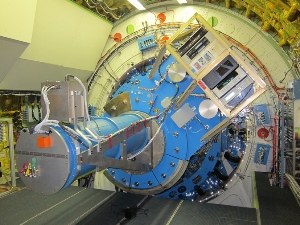Jun 5 2014
Astronomers are eagerly waiting to begin use of a new instrument to study celestial objects: a high-resolution, mid-infrared spectrograph mounted on NASA's Stratospheric Observatory for Infrared Astronomy (SOFIA), the world's largest flying telescope.
 EXES, the Echelon-Cross-Echelle Spectrograph, made its first light commissioning flight on April 7, 2014 on NASA's SOFIA flying observatory. The instrument, shown mounted to SOFIA's telescope bulkhead, can split light from the telescope into an infrared "rainbow." (Image Credit: NASA/SOFIA/EXES/Mathew Richter)
EXES, the Echelon-Cross-Echelle Spectrograph, made its first light commissioning flight on April 7, 2014 on NASA's SOFIA flying observatory. The instrument, shown mounted to SOFIA's telescope bulkhead, can split light from the telescope into an infrared "rainbow." (Image Credit: NASA/SOFIA/EXES/Mathew Richter)
This new instrument, the Echelon-Cross-Echelle Spectrograph (EXES), can separate wavelengths of light to a precision of one part in 100,000. At the core of EXES is an approximately 3-foot (1 meter) bar of aluminum called an echelon grating, carefully machined to act as 130 separate mirrors that split light from the telescope into an infrared "rainbow."
SOFIA is a heavily modified Boeing 747 Special Performance jetliner that carries a telescope with an effective diameter of about 8-feet (2.5-meters) at altitudes of 39,000 to 45,000 feet (12 to 14 km), above more than 99 percent of Earth's atmospheric water vapor. Lower in the atmosphere, at altitudes associated with most ground-based observatories, water vapor obscures much of what can be learned when viewed in the infrared spectrum.
"The combination of EXES's high spectral resolution and SOFIA's access to infrared radiation from space provides an unprecedented ability to study celestial objects at wavelengths unavailable from ground-based telescopes," said Pamela Marcum, a program scientist at the SOFIA Science Center and Program Office in Moffett Field, California. "EXES on SOFIA will provide data that cannot be obtained by any other astronomical facility on the ground or in space, including all past, present or those observatories now under development."
EXES successfully carried out its first two flights on SOFIA on the nights of April 7 and 9, according to Matthew Richter, leader of the team that is developing the instrument at the University of California, Davis, Physics Department. EXES is a collaboration between U.C. Davis and NASA's Ames Research Center in Moffett Field.
"During the two flights, EXES made observations to investigate and characterize the instrument's performance. All the main goals of these observations were successful, although further commissioning flights are required to test EXES in all of its modes," said Richter.
On the first commissioning flight, EXES observed emissions from Jupiter's atmosphere in two molecular hydrogen lines. These observations will be used to understand how gas rises from deep in Jupiter's interior and mixes into the planet's upper atmosphere.
During the second commissioning flight, EXES observed a young, massive star in the constellation Cygnus that is still embedded in its natal cocoon. The star, known as AFGL 2591, warms up the surrounding interstellar dust and causes ice coatings on the dust to evaporate. The warmed dust provides an excellent background infrared "lamp" to probe the chemical make-up of the intervening gas.
New stars and planets are forming from that material through processes similar to the ones that made the sun and Earth. These observations are designed to study water vapor around the protostar, and demonstrate that EXES can detect absorption from the lowest energy level of water molecules despite interference from water vapor from Earth's atmosphere.
"Of the observations obtained during the instrument's first flights, only one can be done from the ground, albeit with some difficulty, and the others are impossible from even the best ground-based telescope sites because the water in Earth's atmosphere is opaque at these wavelengths," Richter said. "While space observatories are above Earth's atmosphere, the massive optical equipment required to separate the light as finely as EXES does – EXES weighs almost 1,000 pounds – would be a challenge to launch into space. In these observations, the spectral features we are studying are narrow, and finely dividing the infrared spectrum to detect them is exactly what EXES was designed to do."
SOFIA is a joint project of NASA and the German Aerospace Center (DLR). The aircraft is based at and the program is managed from NASA Armstrong Flight Research Center's facility in Palmdale, California. NASA's Ames Research Center, manages the SOFIA science and mission operations in cooperation with the Universities Space Research Association (USRA) headquartered in Columbia, Maryland, and the German SOFIA Institute (DSI) at the University of Stuttgart.
For more information about SOFIA, visit: http://www.nasa.gov/sofia or http://www.dlr.de/en/sofia
For information about SOFIA's science mission, visit: http://www.sofia.usra.edu or http://www.dsi.uni-stuttgart.de/index.en.html